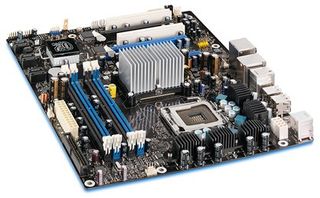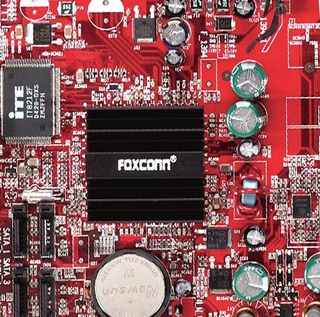The 2008 PC Builder's Bible
Find the best parts. Learn to build a rig from scratch and overclock it to kingdom come. PC Gamer shows you how

The importance of a good motherboard can’t be overemphasized. Every byte of data your computer processes must pass between several components before it reaches you, and the motherboard is the highway. The last thing you want is a metaphorical traffic jam between CPU, RAM, and videocard when you’re trying to frag.
Should your next motherboard be BTX and support both SLI and DDR2? Don’t be embarrassed if you don’t know the answer—our CliffsNotes primer on top-end mobo technology will have you spouting geek-speak in less time than it takes to burn a DVD.

PCI EXPRESS
PCI Express has become a de-facto motherboard standard seemingly overnight, despite the fact it hasn’t demonstrated much of a performance boost over the older AGP standard (at least not in single-card configurations). PCI-E joins the trend of moving away from wide, slow interfaces with lots of pins to narrow, high-speed interfaces. It increases the available bandwidth for graphics from AGP’s 2GB/s to a whopping 8GB/s. But PCI-E’s real graphics promise lies in its upstream bandwidth throughput: 4GB/s compared with AGP’s 133MB/s.
For add-in cards, the standard x1 PCI-E connectors offer about 300MB/s second of throughput—just about double that of a standard PCI slot. Considering the amount of integration on today’s motherboards, however, few components really need to be added. For this reason, we’ve not yet seen any real application for x1 cards; but that’s likely to change as soon as software developers create applications that take advantage of PCI-E.
BTX FORMFACTOR
The BTX motherboard formfactor moves the processor to the front of the case, relocates the chipset to deliver higher I/O speed, and provides better component cooling. Despite these advantages, BTX has been greeted with about as much enthusiasm as turd casserole at a pot-luck. Much of the resistance springs from chassis manufacturers, who are reluctant to spend $50K to retool their assembly lines. AMD, meanwhile, has publicly stated it won’t embrace the standard unless customers demand it. While we think BTX is a smart design improvement, it’s pretty much dead in the water. You can safely stick with the tried and true ATX formfactor until the next challenger comes along.
ATX 12V 2.0
PCI Express graphics cards can suck up to 75 watts of power, compared with AGP's 50-watt maximum. ATX 12v 2.01-compliant power supplies feature a 24-pin connector that jacks into new PCI Express-capable motherboards. The good news is that you don't necessarily have to buy a new PSU to run your new 24-pin mobo. Many motherboards with a 24-pin connector are keyed to accept an older 20-pin PSU; the extra four pins are simply left vacant. To make up for the lack of power, some new motherboards allow you to supplement the mobo's main power by plugging in a second, four-pin connector.
NCQ and SATA 3Gb
SATA 3Gb is a pretty simple concept: Take SATA’s maximum transfer rate of 150MB/s, double it to 300MB/s, and you get SATA 3Gb. Today’s hard drives don’t need the throughput, but there’s no reason not to have it on a new motherboard. Native command queuing is probably more important. NCQ enables a hard drive and its controller to intelligently reorder data requests, so the combo can scoop up and write data faster. Although we’ve seen only small performance boosts from NCQ so far, it’s a good idea to have it on whatever motherboard you choose.
Sign up to the GamesRadar+ Newsletter
Weekly digests, tales from the communities you love, and more

High-Definition Audio
High-Definition Audio bumps maximum audio resolution from AC-97’s 20 bits up to 32 bits, while sampling rates are boosted from AC-97’s 48kHz max up to 192kHz. HD Audio supports up to eight analog channels, where AC-97 supported only six. PCs outfitted with HD Audio will also support a host of Dolby technologies, including Dolby Headphone, Dolby Virtual Speaker, Dolby Digital Live, and Dolby Pro Logic IIx. Dolby Pro Logic IIx might be the most interesting. This technology can encode a stereo or 5.1-channel audio stream—including game audio—into 6.1 or even 7.1 channels in real time.
So what’s the catch? Most audio experts we’ve talked to contend that it will be all but impossible for HD Audio to match the fidelity of even a three-year-old PCI soundcard because of all the electrical noise motherboards generate.

Buy the right motherboard in six easy steps
Head back to the table of contents
PC Gamer is the global authority on PC games and has been covering PC gaming for more than 20 years. The site continue that legacy today with worldwide print editions and around-the-clock news, features, esports coverage, hardware testing, and game reviews on pcgamer.com, as well as the annual PC Gaming Show at E3.
Most Popular


